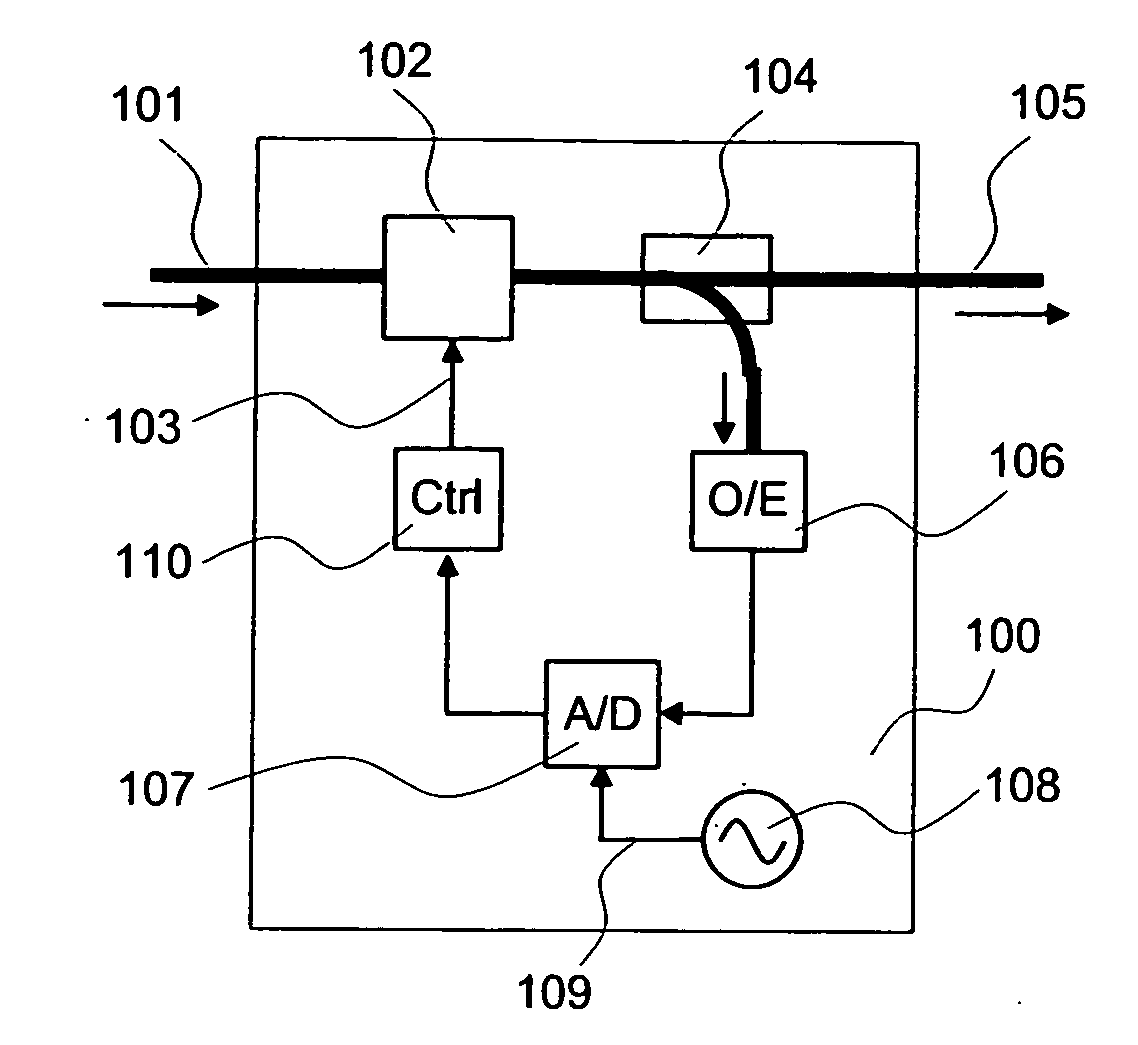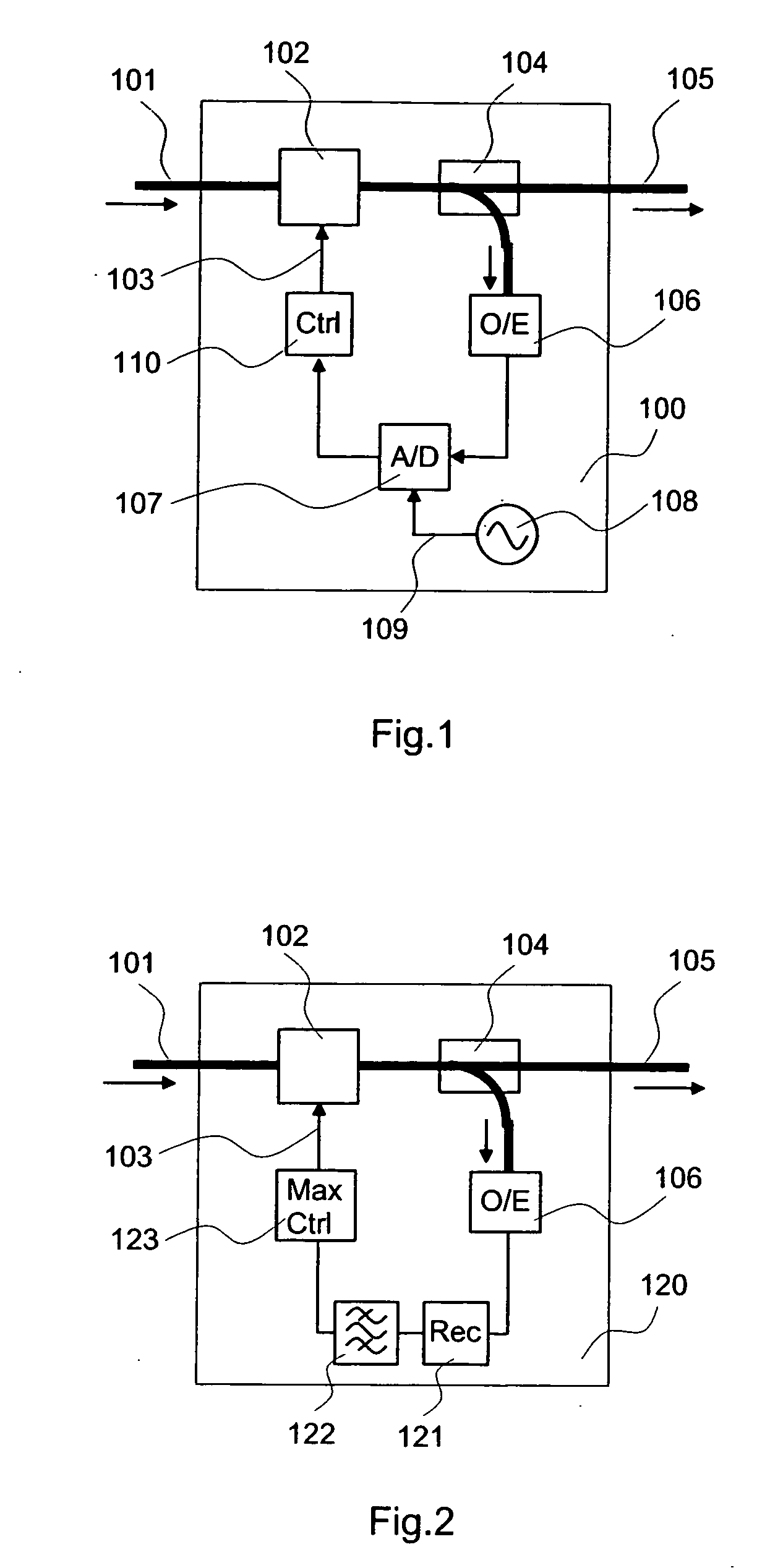Signal waveform deterioration compensator
a compensator and signal waveform technology, applied in the field of optical data transmission, can solve the problems of difficult one circuit to cope with such a wide variety of bit rates, poor optical fiber polarization mode dispersion, and inability to pull, so as to minimize the waveform deterioration, minimize the signal waveform deterioration automatically, and achieve the effect of compensating for a deterioration factor in optical fiber transmission
- Summary
- Abstract
- Description
- Claims
- Application Information
AI Technical Summary
Benefits of technology
Problems solved by technology
Method used
Image
Examples
first embodiment
[0040]FIG. 1 is a block diagram showing the present invention and illustrates the configuration of an automatic chromatic dispersion compensator 100 according to the present invention, as an example.
[0041] An optical digital data signal entered through an input optical fiber 101 undergoes compensation for deterioration caused by chromatic dispersion as it passes through a variable optical chromatic dispersion compensator 102 and the compensated optical signal is outputted through an output optical fiber 105. Part of the compensated optical signal is branched by an optical splitter 104 and converted into an electric signal by an optical detector 106 before entering an A / D converter 107 as a sampling circuit. The A / D converter 107 samples the amplitude of the input electric signal according to the timing of a sampling clock 109 which is generated by a clock source 108 and asynchronous with the data signal. A control circuit 110 generates a chromatic dispersion control signal 103 match...
second embodiment
[0054]FIG. 7 shows the present invention and illustrates the configuration of an optical transmitter according to the present invention. An optical signal from an optical transmitter 130 is transmitted through an optical fiber transmission line 131-1, then amplified as an optical signal by an optical repeater 132 consisting of an optical amplifier like an optical fiber amplifier and transmitted again through an optical fiber transmission line 131-2, amplified by an optical preamplifier 133 and sent to an automatic chromatic dispersion compensator (or PMD compensator) 100 according to the present invention. The optical signal which has undergone waveform deterioration compensation is sent to an optical receiver 134 where it is reconverted into an electric data signal. In this arrangement, there is no communication of electric signals between the automatic chromatic dispersion compensator 100 and the optical receiver 134 and they can be completely independent from each other. This is ...
third embodiment
[0056]FIG. 8 shows the present invention and exemplifies that the present invention is applied to a wavelength division multiplexing system and incorporated in an optical receiver. Optical signals with different wavelengths λ1, λ2 and λ3 from optical transmitters 130-1, 130-2 and 130-3 are multiplexed by an optical wavelength multiplexer 137 and transmitted through a single optical fiber transmission line 131, then amplified by an optical preamplifier 133 before being demultiplexed into separate signals with wavelengths λ1, λ2 and λ3 by an optical wavelength demultiplexer 138. These different wavelength optical signals are respectively sent to automatic chromatic dispersion compensation optical receivers 135-1, 135-2 and 135-3 which incorporate automatic chromatic dispersion compensators (or PMD compensators) according to the present invention. In this configuration, an optical detector 106 is also used as an optical detecting section of an optical receiver for digital data receptio...
PUM
 Login to View More
Login to View More Abstract
Description
Claims
Application Information
 Login to View More
Login to View More - R&D
- Intellectual Property
- Life Sciences
- Materials
- Tech Scout
- Unparalleled Data Quality
- Higher Quality Content
- 60% Fewer Hallucinations
Browse by: Latest US Patents, China's latest patents, Technical Efficacy Thesaurus, Application Domain, Technology Topic, Popular Technical Reports.
© 2025 PatSnap. All rights reserved.Legal|Privacy policy|Modern Slavery Act Transparency Statement|Sitemap|About US| Contact US: help@patsnap.com



